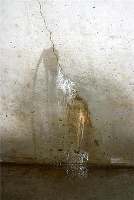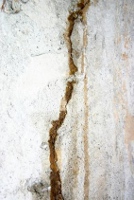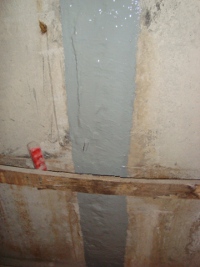|
Foundation Cracks
Non-Structural Foundation Cracks: Wet and Leaking
Most concrete foundation cracks are strictly leaking problems, especially during heavy rains. Not only can excess water in the basement potentially damage or ruin valuable items, but chances for mold and mildew growth are significantly higher, which directly impacts a home's indoor air quality. Basement wall cracks also have the ability to widen. While a particular crack may not necessarily be a problem at the time, that can change as soon as the next heavy rain storm arrives. After a foundation crack forms, the prospect of water seepage (whether slight or major) is not a matter of if, but a matter of when. If water leakage from a foundation crack is minimal now, the potential exists for the crack to widen, allowing further seepage into the basement. These basement wall cracks, resulting from shrinkage, generally take place within the first 28 days after a foundation has been poured. As water within the concrete evaporates, the concrete shrinks. Unfortunately, the wetter the concrete mix is, the more shrinkage is going to occur, which ultimately weakens the foundation. In addition, natural settling of the foundation also leads to concrete cracks. For wet and leaking concrete foundation cracks, the preferred injection material is urethane foam. Urethane foam is a flexible material that injects into the crack. Upon contact with water within the crack, urethane foam reacts by expanding up to 30x it's original form throughout the void, thus filling the crack with a tough, yet flexible barrier. Structural Foundation Cracks Foundation cracks forming as a result of structural deficiencies can pose a serious threat to the home's foundation. Horizontal cracks, or cracks wider than a quarter of an inch are general signs of a structural crack. Structural cracks typically form as a result of wall movement from thermal changes, uneven loading and settling of the footing, soil pressure and/or soil shrinkage, heavy equipment contact or accidental collision. For the repair of structural foundation cracks, the injection material best suited is an epoxy gel, which bonds with the concrete making it 10x stronger than it was originally. Because the crack was initially caused by stress resulting from movement of the foundation, epoxy works to seal the crack, but epoxy by itself, will not prevent further foundation cracking.
Previously Repaired Cracks Have a crack that has been previously repaired? We have the solution! After the area has been prepped and cleaned (which is sometimes quite the chore!), we apply our AquaShield system. This is a permanent bond, similar to a swimming pool liner, which seeps into the pours of concrete holding water pressure 40x the average lbs. per sq. inch of a newer foundation.
|




